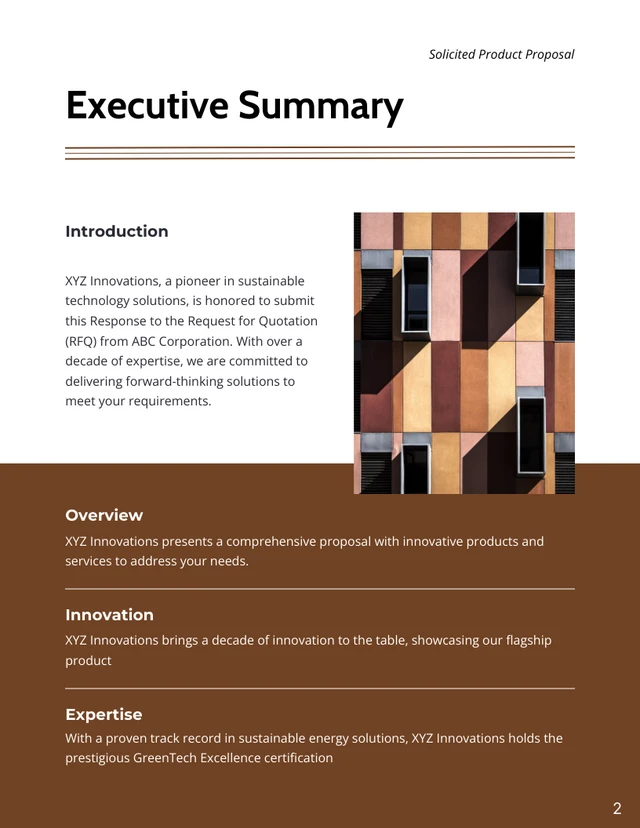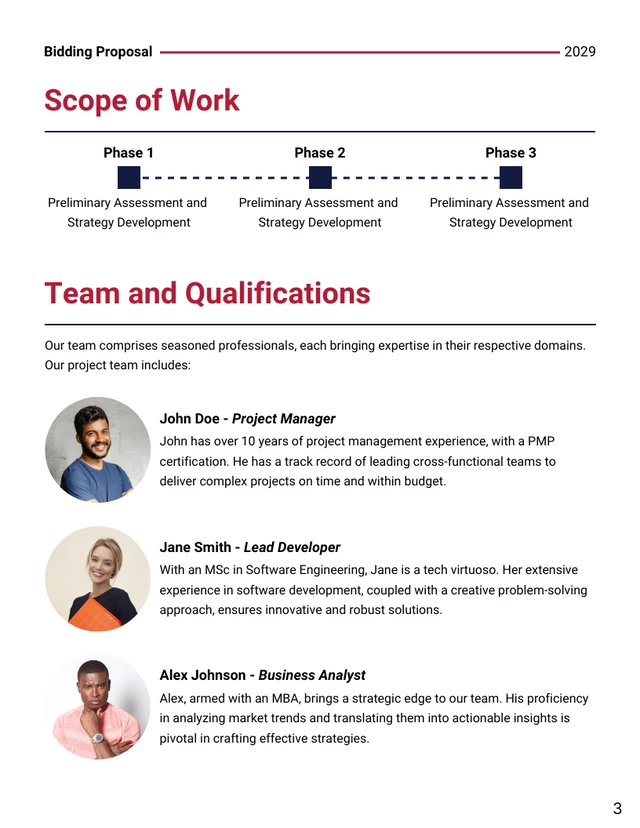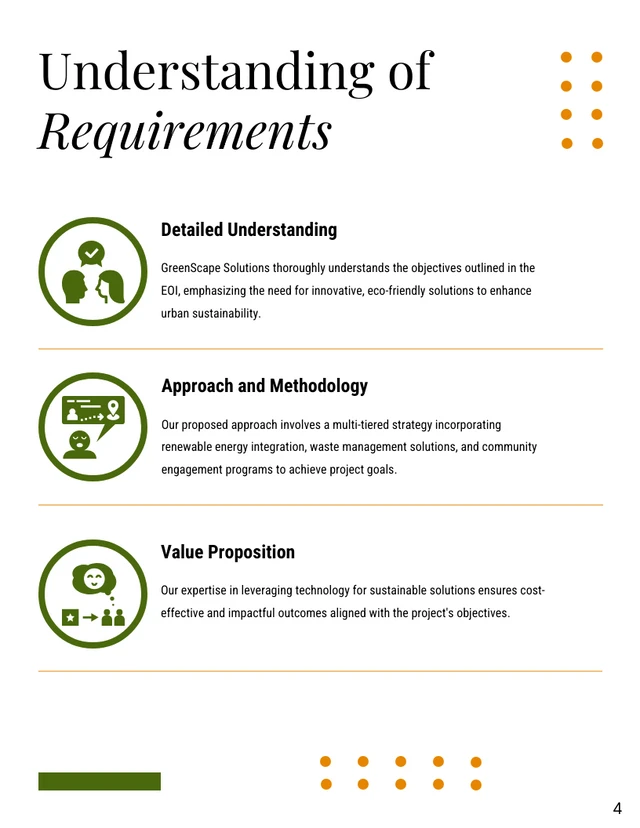
What is a request for proposal (RFP)?
A request for proposal (RFP) is a document issued by companies to solicit bids from vendors for a project or service. It helps establish a clear outline of goals, needs, timeline, budget, and evaluation criteria.
RFPs not only help the issuer ensure a fair and transparent selection process but allow service providers to maximize their chance of winning a contract.
Here’s a great example of an RFP template you can issue to potential clients or vendors.

What is included in an RFP?
While there’s no formula to creating RFPs, ensuring a clear and well-structured document is important if you want to attract the best vendors.
Here’s what you should include in RFPs.
Issuer’s background
Before vendors pitch to you, they need to know who you are, what you stand for, and the problem they need to solve solve for you.
In this section, consider including the following information.
- Introduce your company, mission, values, and history.
- Help vendors understand your company culture so they can assess if they’re a good fit.
Project description
A clear project description helps you find vendors that best fit your needs. Also, being transparent in the initial stages reduces risk of misunderstandings and project delays.
- Offer clear details about the project and its goals.
- Be specific about the outcome and importance of your project.
- You can use SMART goals to make the project requirements clearer.
Scope of work
The scope of work section is the core of your RFP since it outlines exact deliverables, timelines, and milestones.
Here are some ideas on what you can include in this section.
- Split the project into phases for better clarity.
- Set tangible, quantifiable outcomes.
- Include details of deliverables, tasks, and deadlines.
Evaluation criteria
This section is your opportunity to share how proposals will be judged. Common evaluation criteria factors include qualifications, experience, cost, and methodology.
Without setting an evaluation criteria, the selection process can become biased and lead to selecting the wrong vendor.
Here’s what you should include in this section of your RFP.
- Define how proposals will be evaluated.
- Mention the factors that will impact selection: Is it cost? Do qualifications take priority? How important is prior experience with a similar project?
- Transparency in evaluation helps vendors structure their RFPs better.
Budget constraints
Adding budget information ensures you get vendors who can deliver within your financial constraints.
Submission instructions
RFPs must include instructions on how to submit bids with clear deadlines, submission format, and contact information for questions.
Here’s how you can make this section effective.
- Provide easy to understand submission guidelines.
- Share preferred submission format, and other important documentation.
- Add contact information, so that vendors can clarify any queries before submission.
Benefits of using an RFP
Using an RFP has many benefits, from helping vendors compete on equal footing, creating a transparent and structured selection process, and facilitating better decision making for organizations.
Ensure a competitive bidding process
RFPs level the playing field and give vendors a chance to compete on the same set of requirements.
The result? Bidders are motivated to present high-quality solutions that best match the needs of an organization.
Crystallizes project clarity
RFPs bridge the gap between vision and execution by helping establish a shared understanding of project requirements between the issuer and vendor though back-and-forth communication.
Promotes informed decision-making
RFPs allow you to ensure the vendor selection process is structured and objective and evaluate proposals side-by-side on merit.
Mitigate risks
RFPs are great at minimizing risk since they help establish a shared understanding between vendors and clients which leads to clear agreements.
How to respond to an RFP?
If you’re vendor, how you respond to an RFP affects your chances of winning a contract. To maximize your chances, here’s what you should do.
Thoroughly review the RFP
Take time to read through the RFP and understand a client’s project requirements and evaluation criteria.
Take time to discuss these details with your team to ensure everyone is aligned on objectives. Also, don’t shy away from asking questions before creating your proposal.
Showcase your expertise
Your project proposal should tell a vendor why you’re the best choice, so highlight experience and expertise that aligns with the project needs.
To gain trust, include case studies with quantifiable metrics to demonstrate your approach and highlight team qualifications and skills.
Create a winning proposal
A successful proposal is one that not only covers all aspects of the RFP but goes above and beyond to address specific issues mentioned by a client.
It’s a good idea to begin with a summary to showcase your understanding of the project.

Make your value proposition the hero
To differentiate your proposal from other bidders, highlight your value proposition. For example, instead of just listing what you can do, demonstrate how your solution is what the client needs.
Another tip is to quantify the positive impact with metrics like savings and emphasize how your approach best meets objectives.
RFP vs RFQ vs RFI
Besides RFP, you might’ve also come across terms like request for quotation (RFQ) and request for information (RFI).
Though all three documents aim to gather information from potential vendors, they differ in the details requested and the selection process stage.
This table breaks down RFP vs RFQ vs RFI.
| RFP | RFQ | RFI |
| Used to seek detailed proposals for large projects. | Required to get costing for specific services or goods. | Helps in gathering general information about vendors. |
| Contains specifics about the project’s scope, goals, and selection criteria. | Specifies the exact product or service needed with quantities needed. | Contains open-ended questions to understand solutions and level of expertise offered by vendors. |
| Used when the client wants a complete solution for a project and wants to evaluate different approaches. | Used when clients want exact prices for a particular product or service. | Used in initial stages of a project to identify potential suppliers and vendors. |
| Results in comprehensive proposals from vendors, highlighting their unique solutions. | Leads to competitive bidding, with delivery terms and conditions. | Contains a summary or report of relevant vendors and their offers. |
Free RFP templates
Creating an RFP can be hard work since you need to be comprehensive in outlining requirements without overwhelming vendors.
This is a situation where RFP templates can be a life-saver. RFP templates provide customizable sections for project goals, scope, timeline, and evaluation criteria you can use as a starting point.
Here’s what you can expect to find in RFP templates.
- Title page & RFP overview: For a brief summary of the project and its purpose.
- Background of issuing organization: For an overview of your company history and experience.
- Project description & scope of work: Contains important details of the project such as goals, deliverables and pricing.
- Evaluation criteria & submission instructions: Specifies how the proposals from vendors will be assessed, has contact information and submission instructions.
Looking for free RFP templates? Venngage, a simple and powerful tool for business communication, has a library of proposal templates that anyone can edit in minutes.
Here’s an RFP template that you can edit on Venngage without any design skills.

FAQs
How long does the RFP process typically take?
The timeline for an RFP varies based on the complexity of a project. Simple RFPs might take 4-6 weeks, while complex ones can span several months.
Is there a cost associated with responding to an RFP?
Typically there is no cost for responding to an RFP. Creating a competitive proposal requires an investment of time and resources.
Can I participate in an RFP if I’m not a large, established company?
Absolutely! Many RFPs encourage participation from qualified small and medium businesses.
What are some best practices for writing a clear and concise RFP?
Best practices to write a clear RFP include: clear definition of project goals, scope of work and evaluation criteria. Keep the language plain and avoid technical jargon.
How can I ensure a fair and competitive RFP process?
Keep your RFP process fair by being transparent about your selection and evaluation criteria. Provide equal access to information for all potential vendors.
What are some common reasons RFP proposals get rejected?
Common reasons for RFP proposal rejections are submitting incomplete or unclear proposals, not meeting all RFP requirements, and lack of a strong understanding of the project needs.
Is it okay to ask clarifying questions after receiving an RFP?
Yes, it’s encouraged to get clarity with questions! Most issuers will have a designated Q&A period and offer their contact information in the RFP so you can reach them for your queries.
How can I follow up after submitting a proposal?
A professional follow-up email after the submission deadline is acceptable. Be mindful that you’re not overly persistent.
Conclusion: Get the best vendors for your project with well-organized and easy to edit RFP templates
Project success isn’t a matter of luck but the result of a process-oriented framework that begins by issuing a request for proposals to select the right vendor.
RFPs can be tricky to make if you don’t have much experience which is why using RFP templates is recommended to ensure success.








































